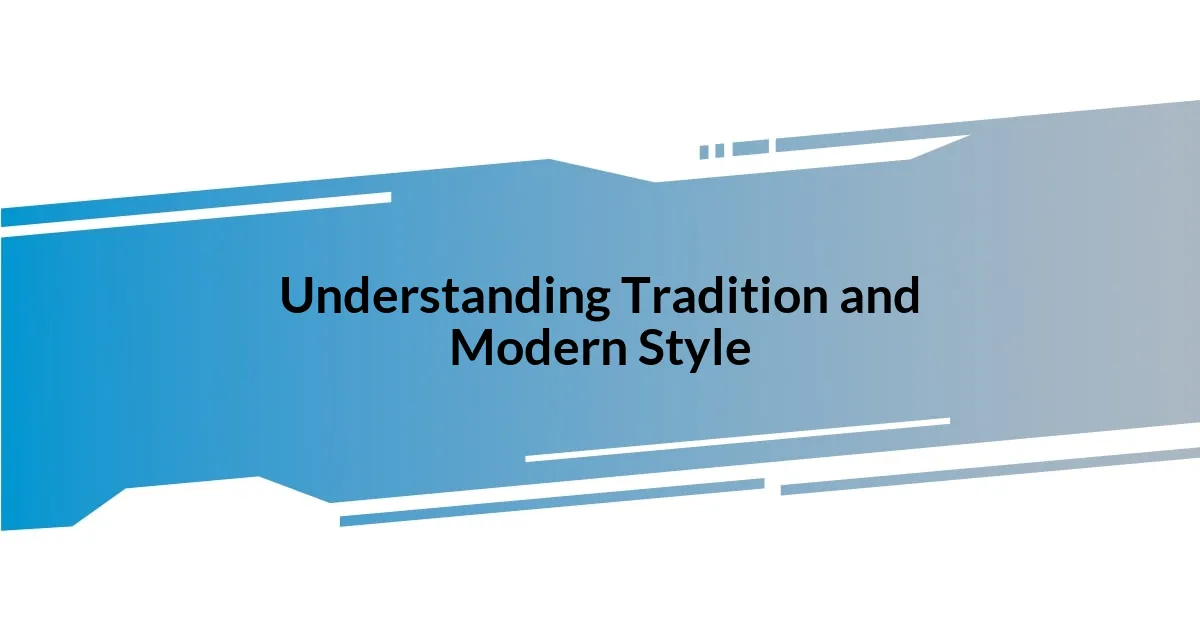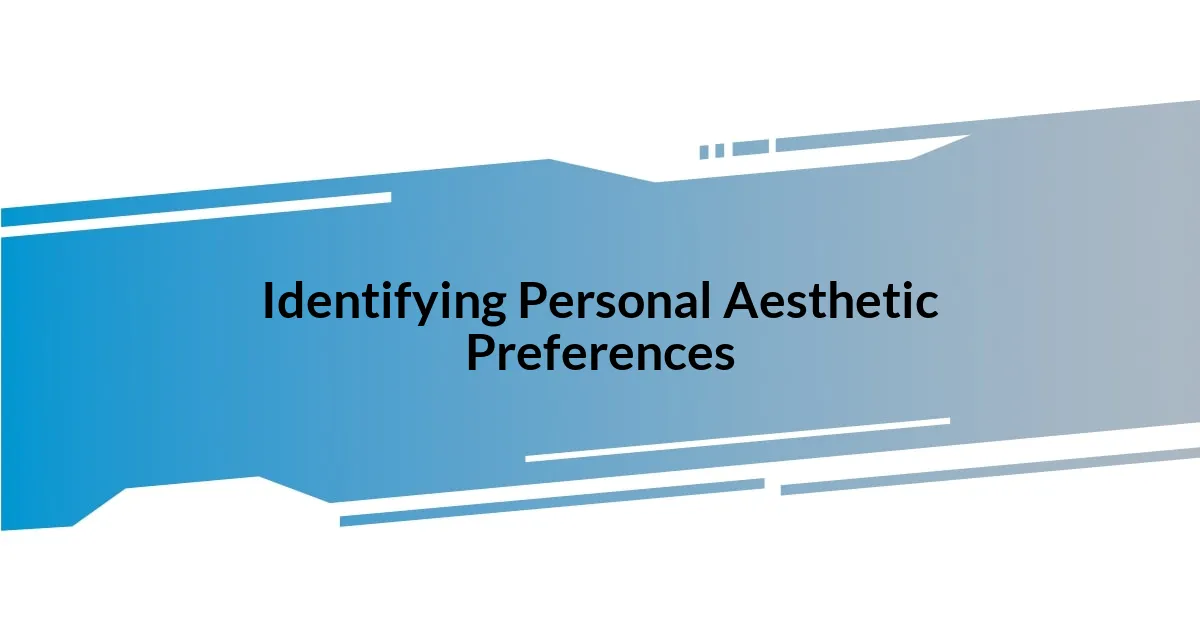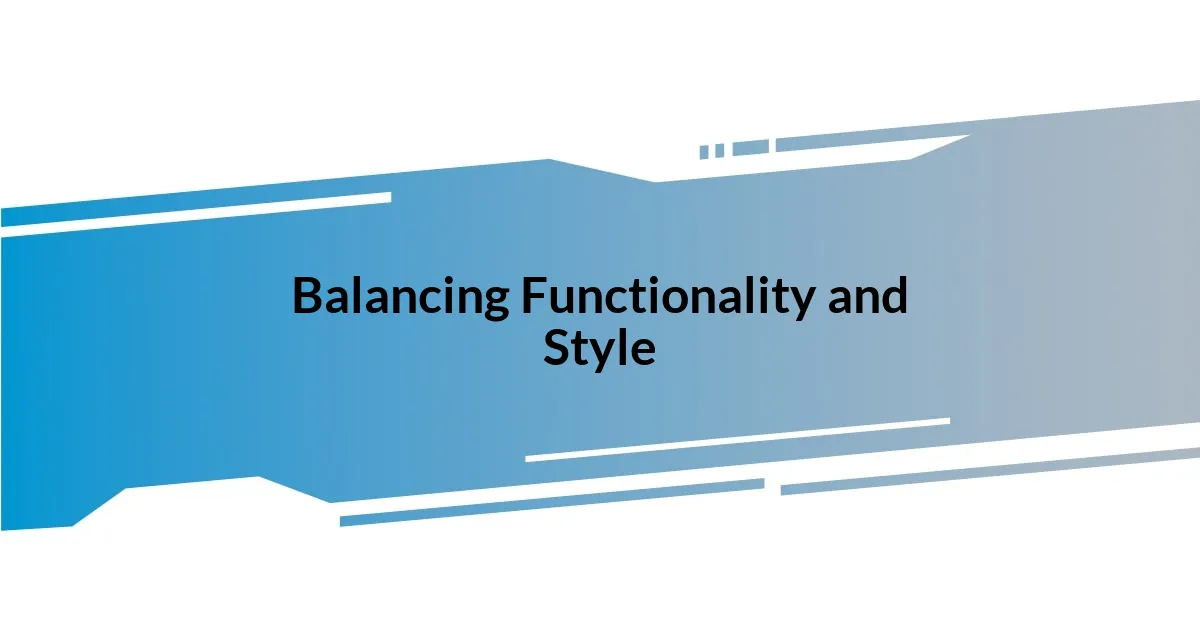Key takeaways:
- Balancing tradition and modern style creates a personal and harmonious aesthetic that honors heritage while embracing innovation.
- Identifying personal aesthetic preferences involves reflecting on emotional connections, inspirations, color palettes, and storytelling in design choices.
- Integrating modern design features with traditional elements can transform a space, enhancing its dynamic through thoughtful contrasts in scale, lighting, and texture.
- Long-term maintenance of decor includes regular inspections, seasonal re-evaluations, and a willingness to change arrangements to keep the space lively and reflective of evolving tastes.

Understanding Tradition and Modern Style
Tradition often holds deep emotional connections, resonating through generations. I remember my grandmother’s stories, rich with cultural nuances, and how they influenced my understanding of heritage. It makes me wonder: how can we honor these stories while still making room for the fresh perspectives that modern style offers?
On the other hand, modern style embraces innovation and individuality. It’s exhilarating to incorporate contemporary elements into my life, like pairing a vintage family heirloom with sleek, minimalist decor. Isn’t it interesting how these contrasts can create harmony, blending the old with the new in a way that feels entirely personal?
As I navigate this balance, I often reflect on the values behind both tradition and modern style. There’s something incredibly grounding about a classic piece of art or furniture, yet I cherish the excitement that new designs can bring. This interplay pushes me to explore: how can we ensure that as we evolve, we retain the core of what makes our traditions meaningful?

Identifying Personal Aesthetic Preferences
Identifying my personal aesthetic preferences has been a journey of reflection and experimentation. I recall the time I discovered a vibrant art deco lamp at a flea market, which sparked my interest in fusing bold patterns with traditional decor. That single piece became a focal point in my living room, blending my love for vintage charm with a pop of contemporary flair. The more I explore, the more I understand that my style doesn’t have to fit neatly into one category; it can evolve as I do.
To pinpoint your aesthetic, consider these reflections:
- Emotional connections: Think about items that carry memories or narratives; do they lean more towards modernity or tradition?
- Key inspirations: Are there specific styles, eras, or cultures that resonate deeply with you?
- Color palette: Notice the colors you’re drawn to—do they feel nostalgic or fresh?
- Textures and materials: Identify if you prefer soft textiles that evoke warmth or sleek surfaces that represent modernity.
- Personal storytelling: Consider how you can weave personal anecdotes and history into your design choices, creating a narrative that is uniquely yours.
Understanding these aspects can significantly sharpen your sense of personal aesthetics, allowing you to make choices that feel genuinely reflective of who you are.

Choosing Key Traditional Elements
Choosing the right traditional elements can significantly shape the aesthetic and emotional resonance of your space. For me, it often starts with family heirlooms. When I decided to showcase my grandmother’s handcrafted quilt, it became a vibrant centerpiece in my bedroom. The quilt’s intricate patterns and stories connected me to my roots while providing a warm, inviting atmosphere that modern pieces often lack.
In addition to heirlooms, I think about traditional colors and patterns. For example, I once attended a workshop on Japanese textiles, which sparked my fascination with indigo dyeing techniques. Incorporating indigo accents into my decor brings not just a striking visual appeal but also a sense of tranquility and heritage. When weaving these elements into modern arrangements, I strive to respect their origins while creating a conversation around cultural appreciation and respect.
I personally find that while adding traditional elements, it’s essential to ensure they resonate with my values and lifestyle. For instance, opting for a rustic wooden dining table not only bridges past and present but also invites friends and family to gather, creating shared memories. It’s all about selecting pieces that speak to your journey and complement the modern touches you cherish, crafting a harmonious blend that feels authentically you.
| Traditional Element | Modern Consideration |
|---|---|
| Heirlooms | Incorporate with contemporary style |
| Colors & Patterns | Enhance with minimalist decor |
| Functional Art | Use everyday items with cultural value |

Integrating Modern Design Features
Integrating modern design features into a traditionally-rooted aesthetic often feels like an exhilarating dance. I remember the first time I added a sleek glass coffee table to my otherwise classic living room. Initially hesitant, I was pleasantly surprised to see how the transparency and simplicity of the table allowed my vintage decor to take center stage, creating a fresh dialogue between the old and the new. Isn’t it interesting how one modern piece can completely transform the room’s dynamic?
One approach I’ve found effective is playing with scale and proportion. For instance, I decided to incorporate oversized art pieces alongside delicate traditional decor, which created a vibrant contrast that breathed life into the space. I still think about the moment my friends visited and exuded admiration for the bold mural I painted, feeling amazed at how it harmonized with the intricacies of my antique furniture. Can you imagine how adding a modern twist to beloved decor can evoke such a reaction?
Lighting serves as another transformative element I’ve explored. By swapping out traditional fixtures for minimalist designs, I’ve managed to maintain warmth while making everything feel more contemporary. I once replaced a heavy chandelier with a streamlined pendant light that matched the color scheme yet contrasted the ornate style of my dining area. The result? An inviting ambiance that encourages effortless conversation and laughter around the table. Who knew that a simple decision about lighting could elevate the entire atmosphere?

Creating a Cohesive Look
Creating a cohesive look involves carefully curating how traditional and modern elements interact in your space. I recall the moment I placed a vintage rug beneath a sleek, contemporary sofa. The juxtaposition not only grounded the modern aesthetic but also infused warmth and history into the room. Isn’t it fascinating how such thoughtful pairings can tell a story?
Textures play a pivotal role in this blend. One of my favorite experiences was incorporating a rough-hewn wooden bench with smooth, modern upholstery in my entryway. This combination sparked conversations about craftsmanship and design, while the contrasting textures felt inviting. I believe that layering different textures is an effortless way to create depth, enhancing the overall aesthetic in a way that feels instinctive and natural.
Color schemes are equally vital in achieving unity. I still remember the journey of selecting a palette that echoed both my heritage and modern sensibilities. Choosing deep earthy tones alongside lighter, airy shades evoked my love for nature while also making the space feel contemporary. Have you ever noticed how a well-chosen color palette can breathe life into a room, making it resonate with emotion and style?

Balancing Functionality and Style
Balancing functionality and style can sometimes feel like a tightrope walk. I vividly remember when I chose to integrate a modern wine rack into my traditional kitchen. At first, it seemed out of place, but once I realized how it freed up cabinet space while adding a stylish flair, everything fell into place. Have you considered how functional decor can elevate both convenience and aesthetics in your home?
Another experience that stands out is when I opted for functional shelving that melded modern design with traditional craftsmanship. These shelves not only displayed my cherished books but also served as an understated art piece, creating an eye-catching focal point in my living room. It was unbelievable how a practical decision turned into a conversation starter every time guests walked in. Do you think it’s this unexpected blend of practicality and beauty that makes our spaces truly inviting?
I’ve also experimented with multi-purpose furniture, which has proven invaluable in making my living areas feel more spacious. I once bought a vintage-inspired ottoman that doubles as storage, beautifully combining function with style. It resonates with nostalgia while cleverly meeting my modern needs—who wouldn’t appreciate furniture that pays homage to the past yet caters to the present?

Tips for Long-Term Maintenance
Maintaining the delicate balance between tradition and modern style requires a bit of ongoing nurturing. For instance, I make it a habit to regularly inspect my vintage furniture for any signs of wear. Just last week, I found a tiny scratch on my beloved mid-century side table. A simple touch-up with a quality wood polish not only restored its shine but also helped preserve its character—don’t you think that little efforts can breathe new life into cherished pieces?
Another tip that has worked wonders for me is the practice of seasonal re-evaluation of decor. Every few months, I take a fresh look at how my space feels. During one of my recent sessions, I realized my vibrant throw pillows were clashing with the more subdued hues of my traditional artwork. By swapping them for softer tones, I achieved a harmony that made the room feel more inviting. Have you ever noticed how subtle changes can create a remarkable difference in your home’s atmosphere?
Lastly, I can’t stress enough the importance of being open to change over time. My collection of antiques has grown, and the layout of my living space has evolved along with it. I constantly find joy in rearranging pieces to form new conversations within the room. Just last month, I moved a classic armchair to a sunlit corner, making it a perfect spot for reading. Doesn’t adapting and playing with your space make it feel more alive and personal?